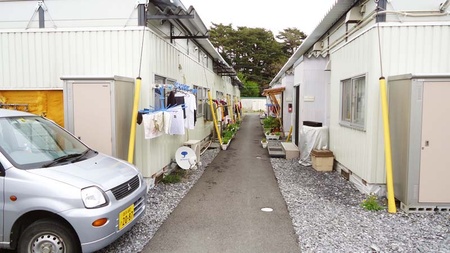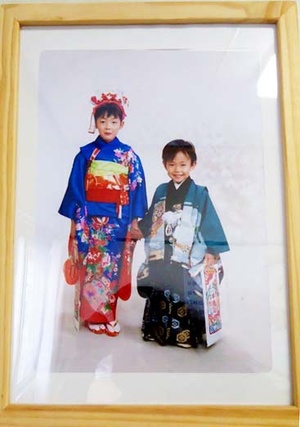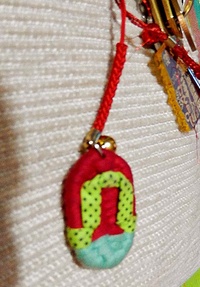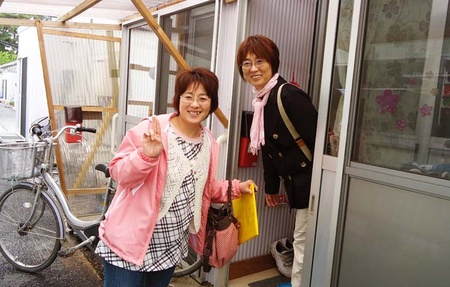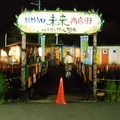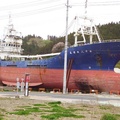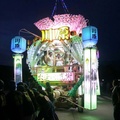Read part 3 >>
4. In the temporary home of Takata High School
After finishing the city tour, Mrs. Okamoto invites us to the temporary home of her younger sister, Junko-san, which is located in the Takata High School area (Takata Koukou). He comes to greet us when we get out of the car, with a big smile, and shows us the way to the entrance. Outside you can see clotheslines with clothes to dry.
Before climbing the small steps to enter the house, we took off our shoes, as is customary in Japan. The place has a kitchen-dining room, a bathroom, and a bedroom. The problem is that the space is limited for a family with children to live.
We sat around a Kotatsu (a table with an electric stove that heats under the futon with which it is covered). On one of the walls of the room is a framed photo of Junko-san's children. The daughter, Shiori-san, is already in high school and the youngest son, Mitsuki-san, is in high school. The photos were taken when they were children, during the “ Shichigosan ” ceremony: they dress in traditional clothes and it is celebrated at the age of 7, 5 and 3 years.
It is one of the photos that they recovered after the tsunami and that could be restored thanks to Kobe Gakuin University, in Kobe. For a year and a half, a group of people from this University have been carrying out this restoration work for those who suffered the tragedy of 2011. On January 1 of each year they send the photos to the people who took the service.
The envelope they mailed to Junko-san reads: “Japan Society for Social Service” and the phrase “we want to protect your memories” inscribed over a drawing of a sun.
“In Kobe they know what it means to go through this kind of situation,” says Keiko-san. She refers to the earthquake with a magnitude of 7.2 on the Richter scale that occurred in that city on January 17, 1995. Next, the sister takes out an album from a bookshelf in the room. They are photos of graduates from the school and university where Junko-san graduated and that they also found in the rubble. Kobe University also restored them and the condition they are in is remarkable.
While we have lunch, the sisters tell us about the situation in the temporary houses. Junko-san is grateful because they gave her a place to live, but she would like to have her own house like before, after these two years.
“The people who live here can't think too far ahead because it will take a long time to rebuild what they had,” she explains sadly. This makes people feel bad because they know it's going to take much longer than they expected. At the beginning, when they built the temporary houses, they had been told that the limit to live there was 2 years. But that time has passed and they are still there.
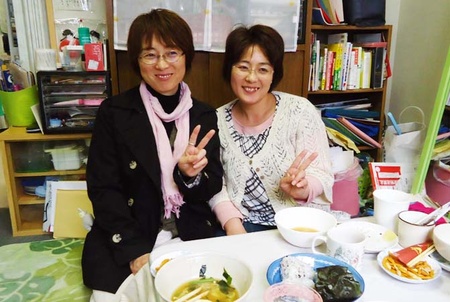
Junko-san cooked lunch for us and we all ate together, while they told us about life in the temporary houses (Photo: M. Laura Martelli G)
To not get depressed, people think about everyday life. They are grateful to be alive and to have survived such a terrible thing. They help each other. In addition, there are many volunteers who travel to RT (Rikuzentakata) to do different types of recovery activities and that makes them feel good. That gives them encouragement and the desire to move forward, despite everything. “This way we don't feel alone,” says Keiko-san.
Despite everything they have been through, you can see great energy and good will for the recovery tasks in the city. When the disaster occurred, no one imagined a tsunami of such magnitude.
There were places in the lower part of the city where the sea took everything away and left nothing. When the wave crashed at the base of the mountains and turned, it left the debris there and it piled up, reaching up to 5 meters. There the rescuers found many bodies.
The night after the tsunami the survivors looked for places to shelter. There was no water, no telephone, no electricity, nothing. Added to that, it snowed that night. The only thing they had was their lives. They didn't know what was going to happen. Since they had no way to communicate, they didn't really know what was happening, or the magnitude of the event.
They were very afraid but they took care of each other and encouraged each other. They were united. They came together and felt like they were one. This is how they managed to spend the first night. Since it was winter, everyone was wearing warm clothes when they fled. That helped them stay warm in the shelters.
The next day, the adults who were in the shelter centers went to see what had happened in the city. The impact was such that they couldn't cry or say anything. At the same time, news came that many people had died and disappeared. Sometimes they didn't even have to get to the place where they lived because from above the mountains you could see the consequences of the disaster: where there used to be neighborhoods with houses, offices, businesses, there was nothing left.
After the tsunami, Keiko-san met up with her younger sister in the afternoon. They knew their family was safe. “Now what are we going to do,” they asked themselves. They had to think of a place to spend the night. There was a site on RT where grandparents and elderly people were cared for. Since an elderly person in their family was there, they went to the place. When they arrived, there was food and water. But more people began to arrive and there was almost no room.
They had to solve the problem of getting water when it ran out, daily care such as personal hygiene and hygiene, and the problem of toilets. They all held meetings to decide what they were going to do, and then the jobs were divided so that everyone could do something for the benefit of all.
To look for water, they organized themselves in turns to go to the mountains that were nearby, to obtain supplies from the source there. They took turns carrying the water and carrying it to the shelter. They also took turns providing everyone with food. They went to the places where they distributed supplies and took them to the shelter.
They coordinated everything by working as a team. In the shelters they made a list with the names of the people present. In this way, with this registry, the search among relatives was facilitated. The emotional impact was great for everyone, especially those who lost loved ones.
There were cases of people who voluntarily decided to go to the sites where the rubble was to help rescue teams search for victims. As many firefighters lost their lives during the disaster, there were not many in number to help everyone. That is why there was no prohibition for volunteers to go because the disaster was of such magnitude that the situation could not cope.
On the second day after the tsunami, the Army, police and firefighters from all over Japan came. In addition to the volunteers, they were distributed throughout the area to help. When they found bodies, they took them out and put something on top of them to indicate that a victim was there, and thus facilitate the rescue service for those missing and deceased in the tragedy.
They used gyms and other places with large spaces to put them, side by side, covered. People who couldn't find family members approached to see if they were there. If they found that person, then they would put some cloth or something on him to show that he was already identified.
It was hard for everyone. There were bodies that were not complete, others that were swollen because they had been in the water for a long time and it was difficult to identify them. They began to do DNA tests to recognize them (in RT there are five fatal victims who could not be identified). They could not be left for long due to the decomposition itself and they had to start cremating the already recognized bodies.
For Keiko-san's family, the most important thing was to take care of her mother because she was an elderly person and had medical treatment that she had to complete. After 3 days without knowing what to do, they began to gather branches and natural herbs so that their mother could drink and her health would not worsen. During the first 3 days they only received one onigiri to eat (rice balls filled with different ingredients wrapped in a strip of seaweed). Among the little food that arrived, they divided it so that everyone could eat something.
As the roads were clogged with debris, and the train tracks destroyed, it took 4 days for food trucks to arrive. When food began to arrive at the supply centers, families were able to go get portions for each one. It took a year for the shops and supermarkets that remained in the city to open. As everyone lacked the same thing, and there were so many people to do procedures in banks, go to the hospital or issues of daily life, that they had to travel to nearby cities and it could take a whole day to do so.
“Together we managed to gather strength and overcome that moment,” says Keiko-san. Her sister leaves the room for a moment and returns with some crafts – two woven sandals for the keychain – made by a woman who lives in the temporary housing area where Junko-san is, to take as a souvenir.
He comments that there are groups of ladies who meet to do this type of crafts. It helps them distract themselves and not feel sad. Generally, it is women who usually get together to talk and do these activities. Men usually stay inside the houses, they don't go outside often. That makes women worry about the physical and emotional health of the men in foster homes. In the character of Japanese men, Keiko-san explains, it is common that they do not talk much compared to women. They don't usually talk about what happens to them and what they feel.
We said goodbye to Junko-san and thanked her for her kindness in hosting us that day. It was a very emotional meeting. Keiko-san takes us to the place where her house was, in the Kawaramachi Town neighborhood. Perform a simulation of what she did when fleeing the tsunami. He tells us to take the time it took him to take shelter in the upper part of the city.
When they told him to flee, the tsunami was already near. She left her house and got into her car. He looked back and saw a cloud of dust. I didn't know what was happening. He felt it was not safe to stay there much longer. He set off with speed to the mountains. It took 30 seconds. He told us that 3 minutes after reaching the upper area, the wave reached where his house was. It's all smooth dirt in the neighborhood where I used to live.
In Kawaramachi only one building remained after the wave hit. There we met Yoshikatsu Sasaki, responsible for organizing the “Ugoku Tanabata Matsuri” Summer Festival, along with his friends from the same neighborhood. There are 10 people who are in charge of maintaining this tradition that dates back more than 300 years in the city of RT.
In 2012 they worked hard to build new floats. Despite adversity, they continue the fight to provide the city's inhabitants with a moment of fun and unity as a community .
© 2013 María Laura Martelli Giachino


